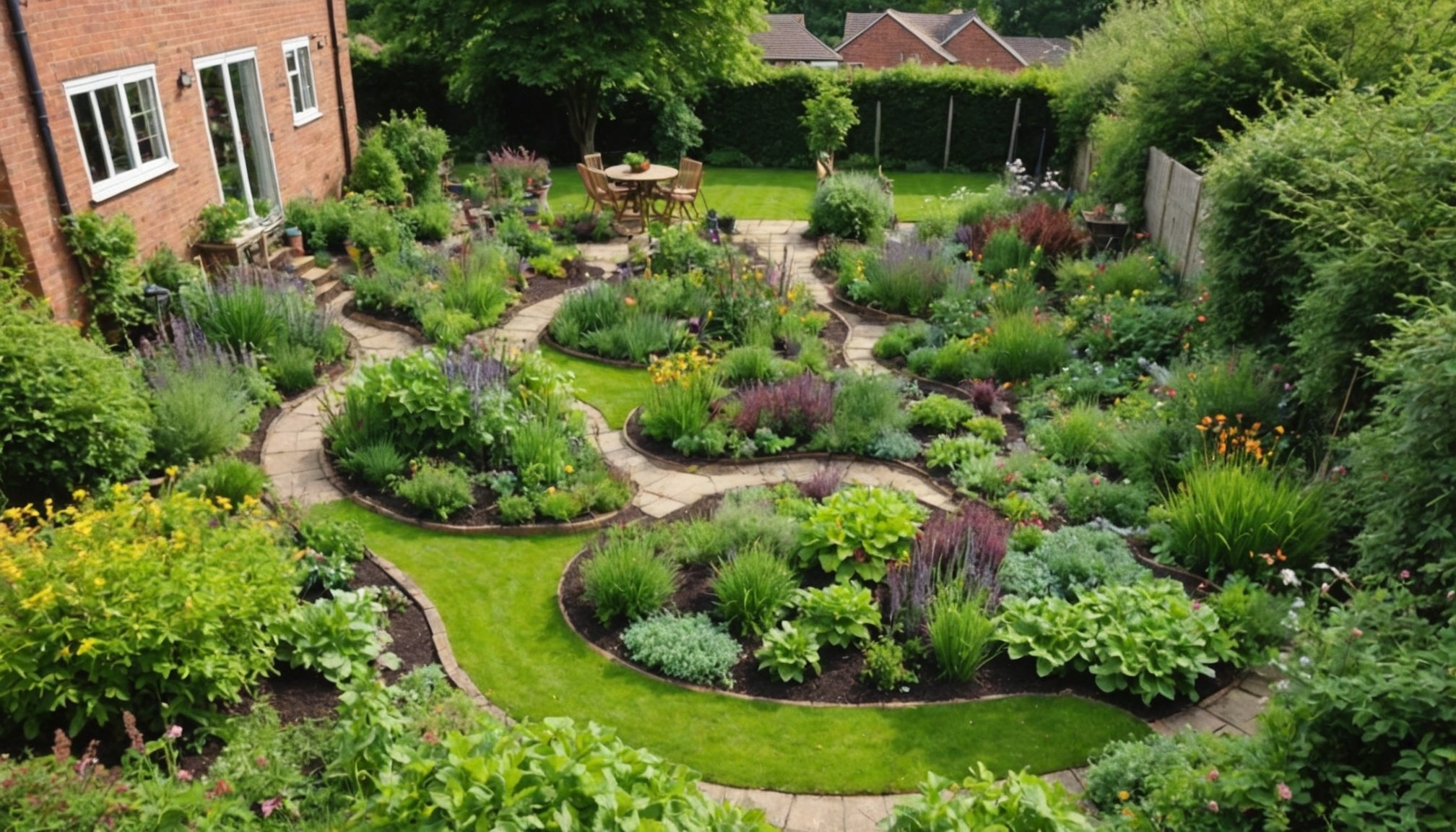Understanding Permaculture Principles
Understanding permaculture principles is essential for anyone interested in creating a sustainable gardening system. At its core, permaculture is an approach to ecological design that seeks harmony between people and nature.
One essential concept is zoning, which involves organising the garden based on how frequently different areas are accessed. For instance, items needing daily attention are placed closer to the home, maximising efficiency. Integration is another key aspect, focusing on combining elements so they work together effectively. This could mean planting species that naturally repel each other’s pests, reducing the need for artificial interventions.
Also read : Discover versatile camo netting options in our online shop
Another critical principle is the idea of a closed-loop system. This involves recycling wastes back into the garden, such as using compost from kitchen scraps for soil nutrient input, enhancing the system’s resilience.
Applying permaculture in suburban settings has notable benefits. It can transform small garden spaces into productive ecosystems, reduce water use, and support local wildlife. Ultimately, permaculture principles guide us in designing a garden that is not only productive but also environmentally sustainable.
Have you seen this : Top Native UK Plants That Draw Beneficial Insects for Effective Organic Pest Management
Space Optimization Techniques
In urban gardening, space optimization is crucial. With limited land, savvy design choices can yield substantial growth. One key strategy is the smart use of vertical space, such as using trellises for climbing plants or hanging baskets for trailing varieties. This approach allows gardeners to maximise space without expanding their ground footprint.
Companion planting boosts yield by pairing plants with mutual benefits. For instance, growing nitrogen-fixing plants alongside nutrient-demanding ones can enhance soil fertility. Certain herbs repel pests, protecting neighbouring crops. This balances the ecosystem and enhances growth in restricted areas.
Creating microclimates within the garden is another powerful technique. These are small zones with distinct climate conditions, achieved through thoughtful layout and planting. Shelter from wind using taller plants or structures can help maintain moisture and warmth, essential for delicate or non-native species.
These techniques create lush, productive gardens even in limited urban spaces, making the most of every inch available. By integrating these methods, urban gardeners can ensure robust plant health and bountiful harvests without needing large plots.
Plant Selection for UK Climates
Selecting the right plants for the UK climate is pivotal in permaculture. The goal is to choose hardy plants adaptable to local conditions, reducing reliance on external inputs. Native species often thrive with less intervention and support local ecosystems. Consider planting resilient options like hawthorn or elderberry, which can withstand varying weather conditions typical in the UK.
For continuous yields, adopt seasonal planting strategies. Incorporate a mix of annuals and perennials to ensure year-round productivity. For instance, plant cool-season vegetables like kale and cabbage in autumn, transitioning to warmer options like tomatoes in spring. Rotating crops not only optimises yields but also supports soil health, preventing depletion.
An emphasis on edible and perennial plants is ideal for suburban permaculture gardens. These selections provide sustenance and often require less maintenance. Consider berry bushes or fruit trees, which offer high yields over multiple seasons with minimal care. Herbs like rosemary and thyme are also excellent choices, providing culinary benefits while enhancing biodiversity. By integrating these strategies, gardeners can create thriving, sustainable gardens suited to the specific challenges of the UK climate.
Designing Your Garden Layout
Careful garden layout design is crucial for successful permaculture. Visualising your space can streamline the implementation of permaculture zones, ensuring every section serves a purpose. Visualising the Garden Design through practical diagrams helps conceptualise efficient layouts and highlight the division between zones.
Common Design Layouts for Suburban Gardens
Common design layouts in suburban gardens often include a mix of low-maintenance and productive spaces. Paths wind through different zones, creating accessibility while respecting natural contours. Design considerations involve placing high-maintenance zones near the home to reduce travel time and effort.
Integrating Zones for Efficiency
Integrating zones for efficiency ensures each area complements the next. This may involve locating composting systems near kitchen gardens for easy recycling of food waste. Successful examples show layouts where water features hydrate areas prone to drying, balancing resource distribution.
- Practical diagrams aid in visualising these interconnected systems.
- Adopt adaptable designs for various garden sizes and shapes.
Strategic garden layout design enhances productivity and sustainability. By focusing on thoughtful layout, gardeners can maximise their space’s potential, making it both functional and beautiful.
Enhancing Biodiversity
Enhancing biodiversity is a cornerstone of sustainable gardening and permaculture principles. In a permaculture system, increased biodiversity contributes significantly to ecosystem health and resilience, creating a balanced environment where plants, animals, and microorganisms thrive.
One effective strategy is incorporating companion planting techniques. This involves pairing plants that naturally support each other’s growth and health. For instance, planting marigolds can repel pests harmful to neighbouring crops, while legumes enrich the soil with nitrogen, benefiting surrounding plants. Such diversity in plant life encourages a variety of insects and pollinators, essential for maintaining a healthy ecosystem.
Attracting beneficial insects and wildlife is crucial for pest control and pollination. Simple measures like placing birdbaths or planting nectar-rich flowers can invite these natural allies into your garden. By fostering a hospitable environment, gardeners can reduce reliance on chemical interventions and promote natural pest management.
Strategies focused on biodiversity not only improve soil health but also build a robust, self-sustaining system. Creating a vibrant ecological network within your garden ensures long-term productivity and environmental resilience, making it a key component of practising permaculture in any setting.
Challenges and Solutions in UK Suburbia
In UK suburbia, gardening challenges often include limited space and poor soil quality. These barriers can be daunting, but permaculture offers practical solutions. For limited space, techniques like vertical gardening can maximise plant potential without requiring expansive ground areas. Enhancing soil health is achievable by adopting composting practices and integrating nitrogen-fixing plants, which naturally enrich the soil.
Suburban gardeners may also struggle with sustainable water use due to unpredictable rainfall. Implementing rainwater harvesting systems helps manage this, directing water to where it’s needed most. Creating sheltered areas within gardens can reduce water evaporation and protect delicate plants from harsh conditions, thus conserving resources.
Successful urban permaculture practitioners provide invaluable insights, showcasing how small urban plots can transform into thriving ecosystems. For instance, examples include using permaculture zones effectively to organise plants based on moisture and sunlight needs. In this way, plants enjoy optimal growth conditions throughout the year.
The application of these permaculture solutions demonstrates that, despite challenges, sustainable and productive gardening is attainable even in densely populated suburban areas. By addressing common suburban issues with informed strategies, gardeners can foster resilient, eco-friendly environments.











